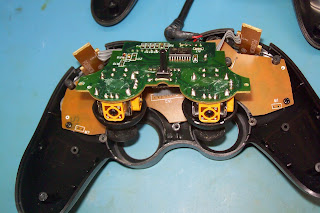The pedals control the pitch of the tail rotor
The Cyclic is the main control and it controls the direction and speed. - We will use a joystick.
7-DEC-2011 UPDATE
The analog board from desktopaviator.com has arrived and works well. FSX sees it as a games controller and my pedals can control Microsoft Flight Simulator.
BUT
I can not work out how (maybe there is no way) to get the pedals to control the helicoper YAW properly. MS flight simulator FSX seems to have an analog input for rudder but when a helicopter model is selected then using the pedals causes the whole helicopter to move sideways in a big arc rather than rotating around the axis of the rotor.
5-NOV-2011 UPDATE - PEDALS
This picture shows the M10 threaded rod foot rests.
This picture shows the mounting of the slider pot using two pieces of 20x20mm RHS aluminum. The connection to the 'crank' was made with a piece of 10x10 angle and M3 screws and nyloc nuts.
4-NOV-2011 ORDERED ANALOGUE - USB BOARD
http://www.desktopaviator.com/Products/Model_2310-2312/index.htm $43USD + Shipping 12 bit analog
Instruction data
1-NOV-2011 PEDAL PROTOTYPE
This mechanism implements the push pull nature of the pedals.
Still to do:-
actual footrests have not been fitted
and adding the pot to transmit the pedal position to the analog board and hence into the computer via USB.
The wood is 70x35 pine framing.
The aluminum is 20x20RHS. So there is a slight misalignment because 3x20=60 and the timber is 70 but for now it is OK.
22-OCT-2011 USB ANALOGUE INTERFACE BOARDS
Gave up on using the canibalised had controller. Looking for a real interface board.
The Pedals are half finished and the collective likewise is pretty much done. Will have to post some photos.
Found two potential sources of analogue input boards.
Leobodnar.com
and
Apogee kits.
Leobodnar seems to have gone AWOL and is not answering emails although his boards claim to show up as games controllers.
Apogee kits are answering emails and so I will ask them what they know about games controllers.
http://www.leobodnar.com/products/BU0836/ $
8 analog inputs with 10-bit (1024 steps) resolution each
12 switches or 32 buttons in a matrix.
Shows up as a game controller I believe
http://www.leobodnar.com/products/BU0836A/ $
8 analog inputs with 12-bit (4096 steps) resolution each+ 12 switches.
http://www.apogeekits.com/usb_interface_board_vm167.htm $US57.95 + PP
- 5 x analog 10 bit resolution inputs: 0…5V / (30K)
- 8 x digital 5V inputs/outputs with on-board LED indication: Input/output mode is selectable in groups of 4 terminals
- 1 x 32 bit pulse counter up to 1MHz input frequency
- 2 x 8 bit 5V PWM outputs: 0 to 100%
- on-board LED indication for I/O and PWM outputs
- output current, PWM: 10mA / Digital outputs: 6mA
http://desktopaviator3.tripod.com/Instructions/Model_2180/index.htm
22-OCT-2011 UPDATE
The picture below shows two boards. A green board with a chip on it and a brown coloured board that I assumed only had the switches on it. So I cut it off. Bad move. Hidden on the other side under a blob of plastic is another chip. The two work together somehow and with the boards separated, it does not work.
Not worth the trouble. So I am investigating proper USB anaogue interface boards. They seem to be reasonably cheap at around $60.
On a more interesting note, The prototype pot for the trottle has been made. The yellow stuff is epoxy. It was moulded inside a piece of the pipe that will form the collective. It could have been made of aluminum but I do not have a lathe so I thought I would try to mould it and it worked.
The collective pot is just an aluminum bracket.
It appears that microsoft flight simulator does not have an input for throttle so the first version of the collective will be just this pot connected to a piece of broom handle. Would a witch would think of that as ironic?
16-OCT-2011
 Plan for a home made "collective"
Plan for a home made "collective"The hand controller that will be sacrificed to provide an analogue in to USB function.
Inside.
One can see the interface chip and two joystick assemblies. The yellow squares are the pots and they measure as 2k2 ohms.








No comments:
Post a Comment